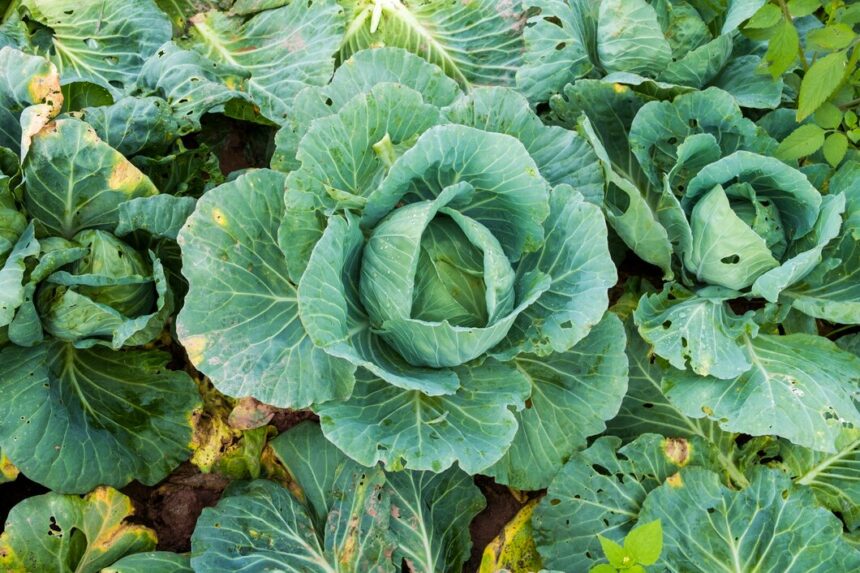Cabbage is a staple crop for many farmers in South Africa due to its high demand and nutritional value. However, like all crops, it is susceptible to pests and weeds, which can severely impact yield and quality. Understanding when and how to use pesticides and herbicides is crucial for effective cabbage cultivation.
Growth Stages of Cabbage and Pesticide Use
- Seedling Stage (0-4 weeks):
- Pests: Cabbage loopers, flea beetles, aphids.
- Pesticides:
- Bacillus thuringiensis (Bt) for cabbage loopers.
- Insecticidal soaps or neem oil for aphids.
- Pyrethroids for flea beetles.
- Symptoms: Chewed leaves, holes in foliage, stunted growth due to sap-sucking aphids.
- Vegetative Stage (4-8 weeks):
- Pests: Cabbage worms, thrips, aphids.
- Pesticides:
- Continue with Bt for cabbage worms.
- Spinosad for thrips.
- Systemic insecticides like imidacloprid for persistent aphid infestations.
- Symptoms: Ragged leaves, silver streaks (thrips damage), distorted leaves.
- Heading Stage (8-12 weeks):
- Pests: Cabbage root maggots, diamondback moths, cutworms.
- Pesticides:
- Chlorpyrifos soil drench for cabbage root maggots.
- Emamectin benzoate or spinosad for diamondback moths.
- Bifenthrin or lambda-cyhalothrin for cutworms.
- Symptoms: Wilting plants (root maggots), small holes and irregular patches on leaves (diamondback moths), severed seedlings (cutworms).
- Pre-Harvest Stage (12-16 weeks):
- Pests: Slugs, snails, continued threat from earlier pests.
- Pesticides:
- Iron phosphate or metaldehyde for slugs and snails.
- Monitor for late-stage infestations and apply relevant pesticides as needed.
- Symptoms: Slime trails and holes in leaves.
Herbicide Use in Cabbage Cultivation
Weeds compete with cabbage for nutrients, water, and light, necessitating the use of herbicides at various stages:
- Pre-Planting:
- Herbicides:
- Glyphosate for broad-spectrum weed control.
- Trifluralin for grass and broadleaf weeds.
- Application: Apply 2-3 weeks before planting to ensure a clean seedbed.
- Herbicides:
- Post-Planting/Pre-Emergence:
- Herbicides:
- Pendimethalin to control annual grasses and certain broadleaf weeds.
- Application: Apply immediately after planting but before the cabbage emerges.
- Herbicides:
- Post-Emergence:
- Herbicides:
- Clopyralid for broadleaf weeds.
- Sethoxydim for grassy weeds.
- Application: Apply when weeds are actively growing and cabbage plants are sufficiently established to tolerate the herbicide.
- Herbicides:
Integrated Pest Management (IPM)
While chemical controls are effective, they should be part of an integrated pest management strategy:
- Cultural Practices:
- Rotate crops to prevent pest buildup.
- Use resistant cabbage varieties.
- Ensure proper spacing to reduce humidity and pest proliferation.
- Biological Controls:
- Introduce natural predators such as ladybugs for aphids.
- Use parasitic wasps for caterpillar pests.
- Mechanical Controls:
- Hand-pick larger pests like caterpillars.
- Use row covers to protect seedlings from insects.
Monitoring and Timing
Regular field scouting is essential to detect early signs of pest infestations and weed growth. Early detection allows for timely intervention with the appropriate pesticide or herbicide, reducing the likelihood of severe crop damage.
- Pest Symptoms to Watch For:
- Caterpillars: Chewed leaves and frass.
- Aphids: Curling leaves, sticky honeydew, and sooty mold.
- Flea Beetles: Small holes and pitting on leaves.
- Root Maggots: Wilting and plant collapse.
- Weed Symptoms:
- Dense weed growth can overshadow and stunt cabbage plants.
- Yellowing or wilting cabbage due to nutrient competition.
Effective cabbage cultivation in South Africa requires a well-rounded approach to pest and weed management. By understanding the growth stages of cabbage and the appropriate timing and application of pesticides and herbicides, farmers can ensure a healthy and bountiful harvest. Always adhere to safety guidelines and recommended dosages to minimize environmental impact and ensure the safety of consumers.
Join 'Farmers Mag' WhatsApp Channel
Get the latest Farming news and tips delivered straight to your WhatsApp
CLICK HERE TO JOIN






